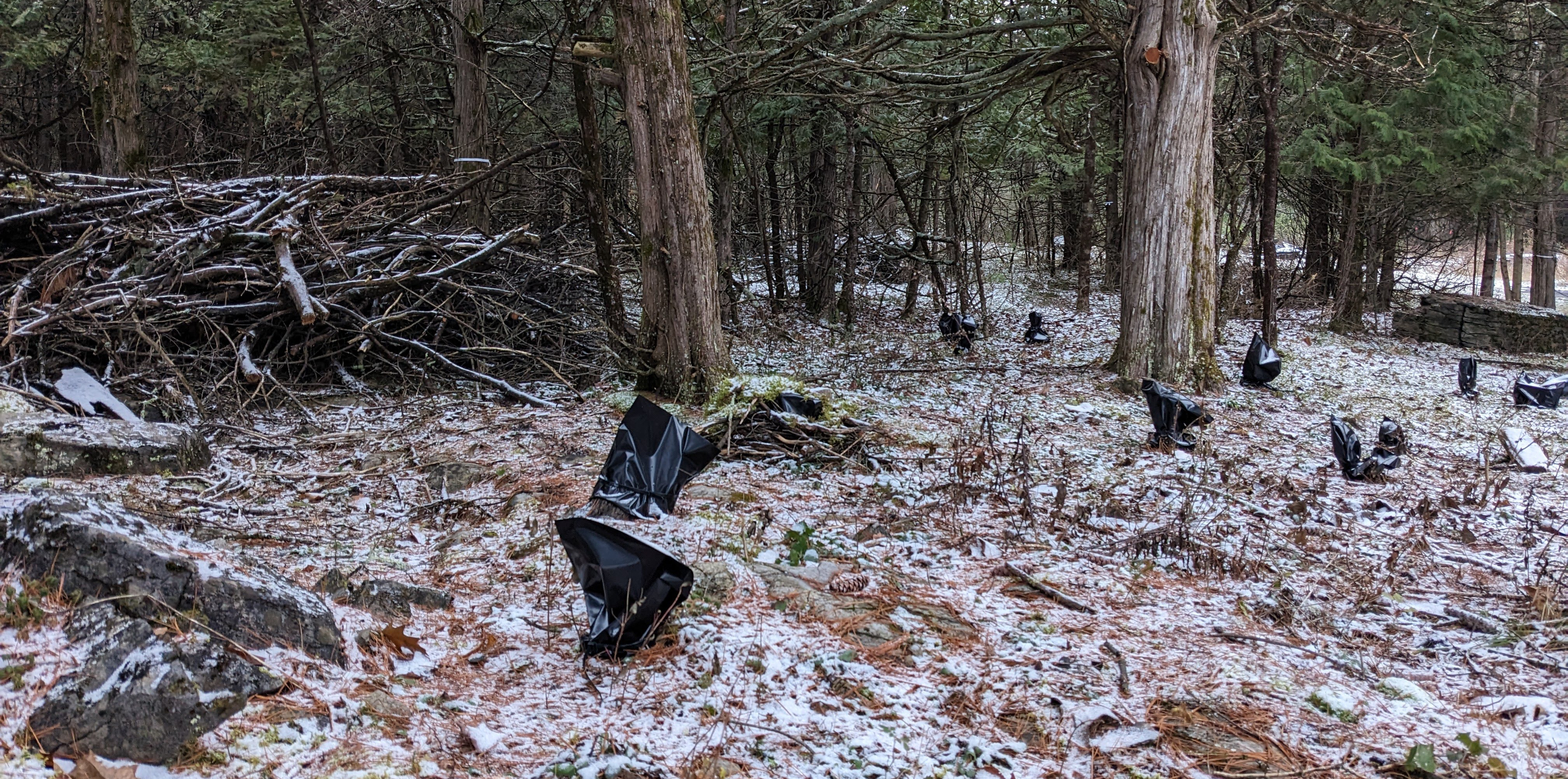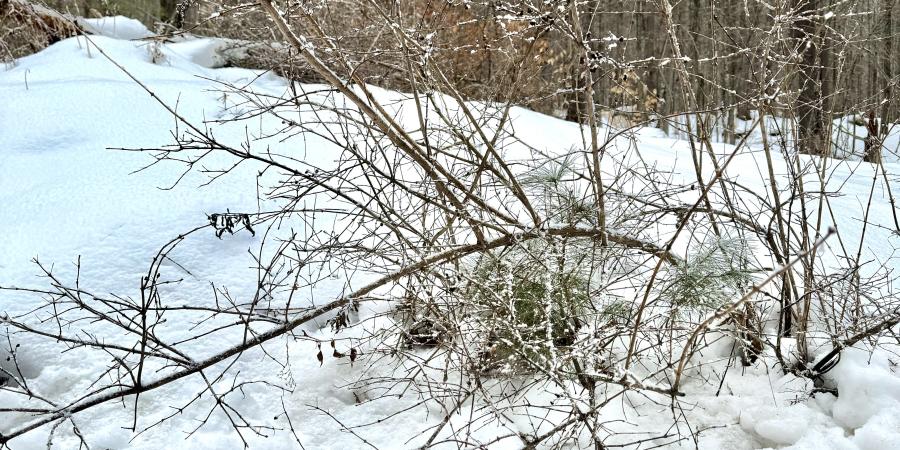If you're familiar with our blogs, you're probably aware of invasive species and the risks they pose to our ecosystems. These non-native plants and animals overtake niches occupied by native species and, if they are allowed to proliferate, ultimately have serious negative ecologic, anthropogenic, or economic consequences. While we generally think of spring and summer when it comes to managing outdoor plants, the colder season can be a great time to begin tackling invasive plant infestations.
What is cold weather control?
Cold weather control is a method for managing unwanted vegetation outside the regular growing season. It's often beneficial, particularly for invasive species removal, because it targets specific species while having little to no impact on any surrounding non-target plants. In general, non-suckering plants with less developed root systems are the best candidates for cold weather control. Plants that have well established, deep roots or that are root suckering (capable of regrowing from their roots or lower stem when their foliage is cut) are more difficult to effectively manage during the cold seasons. However, you can take steps during the cold seasons to manage some types of root suckering plants and make their eradication easier in the spring.
 Some invasive plants are not well suited for cold weather control. This young Japanese knotweed plant was under a foot tall but had already developed roots nearly three feet deep. Japanese knotweed spreads through fragmentation, so attempts to remove it in winter still leaves a significant part of the root system to resprout in spring.
Some invasive plants are not well suited for cold weather control. This young Japanese knotweed plant was under a foot tall but had already developed roots nearly three feet deep. Japanese knotweed spreads through fragmentation, so attempts to remove it in winter still leaves a significant part of the root system to resprout in spring.
Cold weather control for non-suckering woody shrubs
Non-suckering invasive woody shrubs like bush honeysuckles, barberries, and buckthorns respond well to mechanical and chemical cold weather control. You can cut or mow these plants during winter. In the spring, only small shoots will sprout, which can be pulled by hand or treated with foliar herbicides. Herbicides can also be applied to cut stumps during any season to prevent resprouting. An alternative method for managing buckthorn and bush honeysuckle remnants is to cover them with a dark plastic bag for at least one year.
 This tangle of monocultured forest understory is out of season invasive barberry. Cutting these woody shrubs in the winter will greatly reduce their growth in the spring. Photo credit: Leslie J. Mehrhoff, University of Connecticut, Bugwood.org
This tangle of monocultured forest understory is out of season invasive barberry. Cutting these woody shrubs in the winter will greatly reduce their growth in the spring. Photo credit: Leslie J. Mehrhoff, University of Connecticut, Bugwood.org
Support our biodiverse habitats work for wildlife and their habitats. Give with confidence today!
 Cover buckthorn and bush honeysuckle remains with a black plastic bag to prevent regrowth without using chemicals.
Cover buckthorn and bush honeysuckle remains with a black plastic bag to prevent regrowth without using chemicals.
Cold weather control for suckering vines
Invasive vine species such as Asiatic bittersweet, Japanese honeysuckle, and porcelain berry have extensive foliage that can be cut in late fall or winter. It is best to cut these plants close to their base and, in the case of large infestations, at roughly five feet high to ensure complete removal of outgrowth. Because these vines are root suckering plants, new sprouts will have to be removed by hand or treated with herbicides early in the next growing season. It’s important to monitor throughout the summer.
 Japanese honeysuckle often keeps many of its leaves throughout the year, so it is easily identifiable in winter. But because this honeysuckle species is a vine, regular removal of small sprouts will likely need to be done throughout the next growing season, as its roots can grow over five feet deep. Photo credit: Leslie J. Mehrhoff, University of Connecticut, Bugwood.org
Japanese honeysuckle often keeps many of its leaves throughout the year, so it is easily identifiable in winter. But because this honeysuckle species is a vine, regular removal of small sprouts will likely need to be done throughout the next growing season, as its roots can grow over five feet deep. Photo credit: Leslie J. Mehrhoff, University of Connecticut, Bugwood.org
Cold weather control for garlic mustard
Garlic mustard, another invasive species, produces photosynthesizing rosettes that tolerate cold temperatures and often remain visible throughout winter. Late fall and winter days with temperatures above freezing are ideal to manage this invasive plant. Herbicides will function properly, but dormant plants will not be harmed. If the uppermost layers of soil are not frozen, it is possible to remove the whole plant by hand, due to its shallow roots.
 Garlic mustard's overwintering rosettes can be hand pulled or sprayed with an herbicide, so you won’t be inundated with its fast-growing sprouts in early spring. Photo credit: Leslie J. Mehrhoff, University of Connecticut, Bugwood.org
Garlic mustard's overwintering rosettes can be hand pulled or sprayed with an herbicide, so you won’t be inundated with its fast-growing sprouts in early spring. Photo credit: Leslie J. Mehrhoff, University of Connecticut, Bugwood.org
Make sure to plant native species after any invasive species removal to help keep the unwanted plants away. And always remember to check with local guidelines and follow all instructions on the label when using chemical control methods.
Thinking about making cold weather invasive species control one of your outdoor projects this year? Give it a try and discover the benefits. It will make invasive species management a lot easier once spring comes around and will improve the health of the ecosystem around you.
Story by Krista, Research Associate.
Sign-up for our e-newsletter to get weekly updates on the latest stories from the Ausable River Association.


